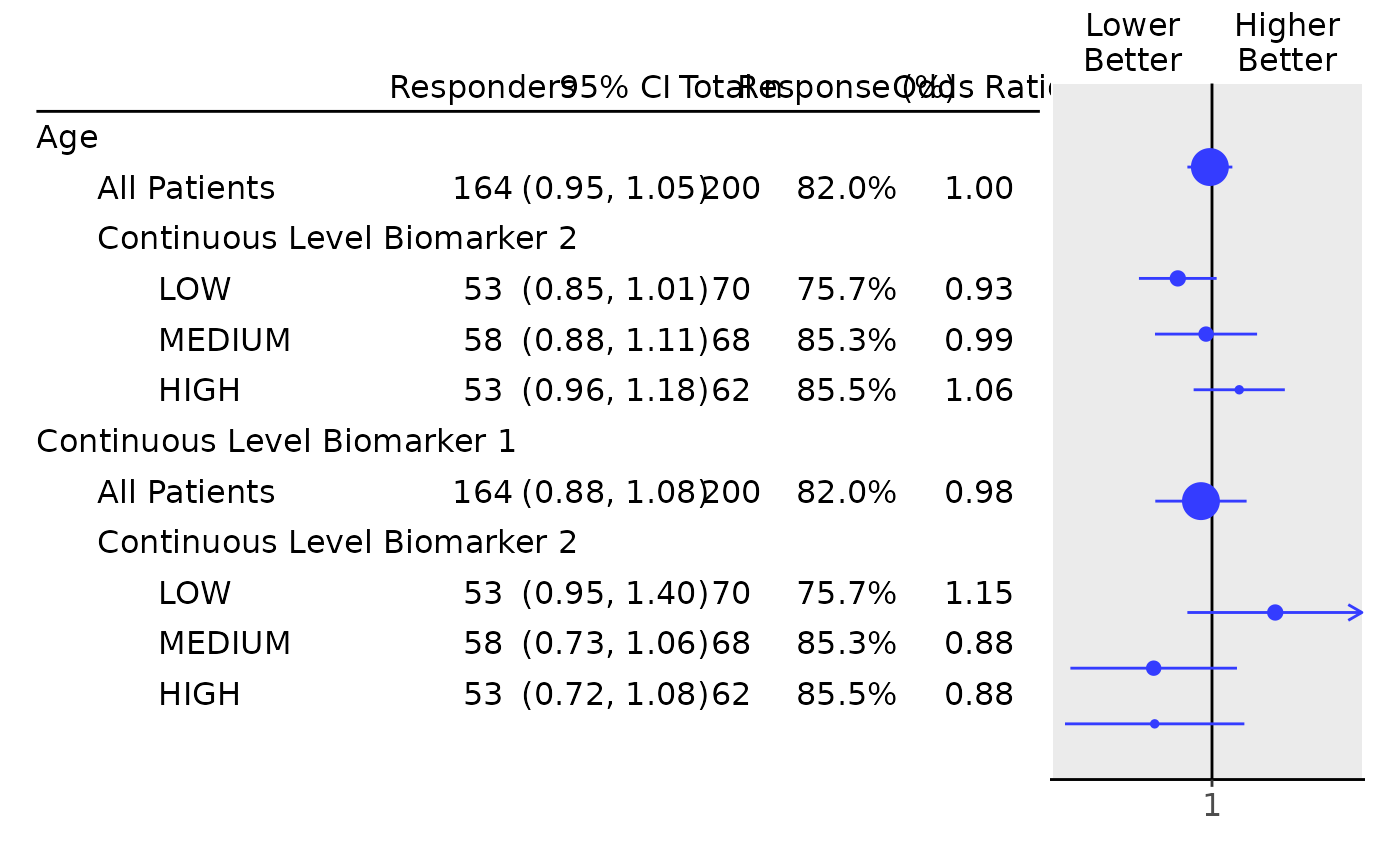Tabulate biomarker effects on binary response by subgroup
Source:R/response_biomarkers_subgroups.R
response_biomarkers_subgroups.RdThe tabulate_rsp_biomarkers() function creates a layout element to tabulate the estimated biomarker effects on a
binary response endpoint across subgroups, returning statistics including response rate and odds ratio for each
population subgroup. The table is created from df, a list of data frames returned by extract_rsp_biomarkers(),
with the statistics to include specified via the vars parameter.
A forest plot can be created from the resulting table using the g_forest() function.
tabulate_rsp_biomarkers(
df,
vars = c("n_tot", "n_rsp", "prop", "or", "ci", "pval"),
na_str = default_na_str(),
...,
.stat_names = NULL,
.formats = NULL,
.labels = NULL,
.indent_mods = NULL
)Arguments
- df
(
data.frame)
containing all analysis variables, as returned byextract_rsp_biomarkers().- vars
(
character)
the names of statistics to be reported among:n_tot: Total number of patients per group.n_rsp: Total number of responses per group.prop: Total response proportion per group.or: Odds ratio.ci: Confidence interval of odds ratio.pval: p-value of the effect. Note, the statisticsn_tot,orandciare required.
- na_str
(
string)
string used to replace allNAor empty values in the output.- ...
additional arguments for the lower level functions.
- .stat_names
(
character)
names of the statistics that are passed directly to name single statistics (.stats). This option is visible when producingrtables::as_result_df()withmake_ard = TRUE.- .formats
(named
characterorlist)
formats for the statistics. See Details inanalyze_varsfor more information on the"auto"setting.- .labels
(named
character)
labels for the statistics (without indent).- .indent_mods
(named
integer)
indent modifiers for the labels. Defaults to 0, which corresponds to the unmodified default behavior. Can be negative.
Value
An rtables table summarizing biomarker effects on binary response by subgroup.
Details
These functions create a layout starting from a data frame which contains the required statistics. The tables are then typically used as input for forest plots.
Note
In contrast to tabulate_rsp_subgroups() this tabulation function does
not start from an input layout lyt. This is because internally the table is
created by combining multiple subtables.
See also
Examples
library(dplyr)
library(forcats)
adrs <- tern_ex_adrs
adrs_labels <- formatters::var_labels(adrs)
adrs_f <- adrs %>%
filter(PARAMCD == "BESRSPI") %>%
mutate(rsp = AVALC == "CR")
formatters::var_labels(adrs_f) <- c(adrs_labels, "Response")
df <- extract_rsp_biomarkers(
variables = list(
rsp = "rsp",
biomarkers = c("BMRKR1", "AGE"),
covariates = "SEX",
subgroups = "BMRKR2"
),
data = adrs_f
)
# \donttest{
## Table with default columns.
tabulate_rsp_biomarkers(df)
#> Total n Responders Response (%) Odds Ratio 95% CI p-value (Wald)
#> —————————————————————————————————————————————————————————————————————————————————————————————————————————————————
#> Age
#> All Patients 200 164 82.0% 1.00 (0.95, 1.05) 0.8530
#> Continuous Level Biomarker 2
#> LOW 70 53 75.7% 0.93 (0.85, 1.01) 0.0845
#> MEDIUM 68 58 85.3% 0.99 (0.88, 1.11) 0.8190
#> HIGH 62 53 85.5% 1.06 (0.96, 1.18) 0.2419
#> Continuous Level Biomarker 1
#> All Patients 200 164 82.0% 0.98 (0.88, 1.08) 0.6353
#> Continuous Level Biomarker 2
#> LOW 70 53 75.7% 1.15 (0.95, 1.40) 0.1584
#> MEDIUM 68 58 85.3% 0.88 (0.73, 1.06) 0.1700
#> HIGH 62 53 85.5% 0.88 (0.72, 1.08) 0.2104
## Table with a manually chosen set of columns: leave out "pval", reorder.
tab <- tabulate_rsp_biomarkers(
df = df,
vars = c("n_rsp", "ci", "n_tot", "prop", "or")
)
## Finally produce the forest plot.
g_forest(tab, xlim = c(0.7, 1.4))
 # }
# }